All wood is subject to some degree of seasoning, i.e., drying until it acclimates to the humidity conditions of the surrounding atmosphere at in-service conditions. Seasoning occurs when the wood is air-dried, dried in a kiln under controlled conditions, or subject to radio frequency drying. As wood loses (or gains) moisture, it will shrink (or swell) until it reaches equilibrium with the constantly changing level of moisture of its immediate environment. As shown in Figure 1, seasoning checks are separations of the wood fibers that develop along the length of lumber or timber due to shrinkage of the wood as it dries.
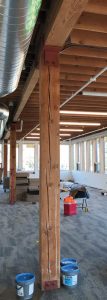
Structural Timber Grades • Nominal 5” x 5” and larger • Commonly sold unseasoned • Seasoning checks are permitted • Design values are not affected by checks
Checks are not defects. Checks, particularly in large, dried timbers, are natural characteristics of timber and very common. To many people, a check may look like a split. However, splits extend through the timber from one face to either the opposite or an adjacent face and are typically the result of rapid drying at the ends of the piece or excessive structural loads.
Checks do not generally affect the design strength of timber; however, these natural characteristics may impact appearance. When a check extends to a timber connection, the connection should be evaluated for fastener-holding capacity and may need to be reinforced or repaired.
Why Do Timbers Check?
In living trees, it is not uncommon for the wood moisture content to exceed 100% when the weight of the water in the wood is greater than the weight of the wood material. After harvesting, the wood begins to dry and eventually begins to shrink as it dries below the fiber saturation point, typically at 26 to 30% moisture content level. As this shrinkage occurs, the timber dries more quickly on its surfaces and at the ends than in its interior.
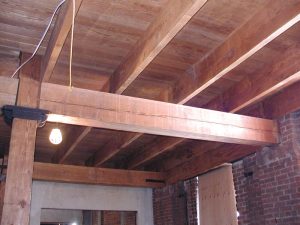
Eventually, timbers, wood framing, and millwork protected from the weather on the interior of a structure will reach an equilibrium moisture content of typically between 6 and 13%, depending on the season and geographic location. Because of the cellular structure of wood, until it reaches equilibrium, it shrinks at different rates in the cross-section (e.g., breadth and depth) than along the length and a greater rate in all three directions at the ends of the timber. This often causes checks to form at the mid-width on the face or the end of the piece as shrinkage occurs, as shown in Figure 2. The outer fibers become smaller than the internal fibers, and “seasoning checks” resembling fissures or cracks on the surface of the wood or end checks may occur.
A seasoning check develops on the outer face of a timber but does not extend to the opposite or an adjacent face. If it does, it is no longer a check but is called a split. Splits can occur at the end of a timber, where drying is the most rapid or checks join together. Splits along the length of a timber, as opposed to checks, are typically not due to drying but, more often, the result of excessive structural loads applied to the timber.
Effect of Checks on Appearance
Before specifying timber for a project, designers and property owners may want to visit several old buildings that contain large timbers to consider the degree of checking to be anticipated over time. Some species have lower shrinkage values and will develop fewer or smaller checks. Shrinkage coefficients for various wood species can be found in the Wood Handbook published by the U.S. Department of Agriculture.
The rustic appearance of checked timbers has an aesthetic quality that may not meet every designer’s or owner’s expectations. Suppose a large cross-section is required, but seasoning checks are to be minimized. In that case, designers may want to consider specifying a low-shrinkage wood species, a lower moisture content at the time of delivery and installation, or consider a different product, such as glulam timbers. However, when the large size and rustic aesthetic of timbers are central to the design, the checks in the timbers may be consistent with the look desired by the architect and owner.
It should be recognized that some degree of checking is virtually unavoidable in large timbers. After the timber reaches equilibrium, several small checks may be visible on the face of the timber. Alternatively, a single, wider check may be visible. The number and width of the checks are a function of the anatomical structure of the wood and how the internal stresses are released as the wood dries. There is no difference in performance between numerous small checks or a single large check other than appearance. This is quite apparent when viewing timbers in an older building where the timbers have been at equilibrium for many years.
How to Reduce Checking?
New timbers of most structures, dried to end-use conditions, are generally not available at the point of sale because of the time it takes for them to dry, and end-use conditions are generally unknown by the mill. As timbers dry after milling, the wood shrinks, often resulting in checking and, occasionally, end splitting.
If desired, there are several options for reducing the amount of checking to be expected in timbers. Timbers can be seasoned and allowed to slowly air dry under moderate conditions before installation (not exposed to direct sunlight, high temperatures, or extremely low relative humidity).
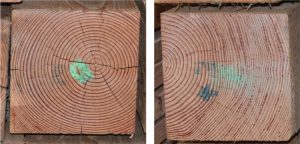
Timbers that contain the pith (center of the tree) are called boxed heart (Figure 3a) and tend to develop more checks than timbers without the pith. Timbers can be specified FOHC “Free of Heart Center” (Figure 3b), which means that the pieces do not contain the pith. Such timbers typically demand higher prices and may be limited in availability. If desired, the FOHC specification can be added to the plan’s general notes or details.
The ends of timbers can be protected temporarily with wax or other coatings containing paraffin or sealer to retard the natural drying process and reduce the likelihood of developing large checks. End coating is available from some timber-producing mills upon request (through buyer/seller agreement on large orders) or may be undertaken at the job site if seasoning checks have not yet begun to develop. End coatings help timbers season more evenly by slowing the drying process during storage and transport before installation. Radiofrequency (RF) drying can dry the timber without producing large checks but at additional cost. Check with local suppliers about the availability of RF-dried timbers.
Kerfing One method for limiting check development in large timbers is to saw a narrow, longitudinal kerf (a deep saw cut to the timber) to the center of the timber surface from the end along the full or partial length. The kerf serves to allow some movement and relieve stresses from drying shrinkage that would otherwise cause the timber to check. While kerfing may reduce the strength of the timber, it can be effective in controlling the development of checks or splits.
Kerfing dates from medieval times and can be specified in assigned locations to provide drying stress relief to avoid or minimize the probability of large checks developing on visible surfaces.
Checking and kerfing in preservative-treated timber may be deeper than the depth of penetration of the treatment, exposing untreated wood to conditions that might lead to decay. If kerfing is to be used, it is recommended that it be done before the preservative treatment process.
Timber Grading Rules and Checks
Timbers (Figure 4) are commonly milled and graded in the unseasoned condition before drying. Checks and end splits are accounted for when the timbers are graded, primarily for appearance, not structural capacity.
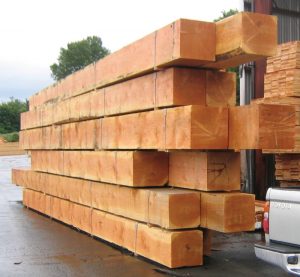
In standard grading rules terminology, members with nominal dimensions of 5 inches x 5 inches and larger are classified as either Beams and Stringers or Posts and Timbers for all species listed in the grading rules except southern pine. For southern pine, all of the larger structural members are called Timbers.
The working stresses for strength grades include adjustments of clear wood strength properties to make allowance for sizes and locations of checks and splits and other natural strength-reducing characteristics (such as knots) that are permitted in the particular grade.
The working stresses, and consequently the allowances for tree-growth and manufacturing characteristics, vary with specific strength grades of a given species. The corresponding permissible characteristics are specified in the grading rules. The design values for horizontal shear require no reductions because checks are already considered in the grading rules.
In the standard lumber grading rules, seasoning checks are allowed in all grades of structural timbers at the time of grading at the mills as listed. Checks and splits are considered time-altering characteristics, so they may develop or get larger after grading at the mills until the timber reaches equilibrium at in-service conditions. The development of checks does not mean that the timber is defective; only that the wood has dried and is reaching equilibrium with the environment of the structure.
Permitted checks and splits in grading rules for new timbers (Western Lumber Grading Rules 2017, Western Wood Products Association) are given in the Table for new timbers based on appearance requirements.
Effect of Checks on Design Values
Other than appearance, seasoning checks do not affect the design strength of a member stressed in axial compression unless checks develop into a through-split that essentially separates the timber into two pieces.
Checks also do not affect members stressed in axial tension unless the checks are at an angle to the grain of the piece and tend to extend across adjacent faces so as to separate the piece in two. This is more of an issue with lower structural grades of timber with large knots or a steep slope of grain (where the wood fibers are not parallel to the long axis of the piece).
Seasoning checks are considered to affect shear stress in bending members, which is seldom the governing design value. Structural timber design values for Shear Parallel-to-Grain are published in the National Design Specification (NDS®) for Wood Construction®, Supplement Table 4D. The published shear design values are determined according to ASTM D245-06, Standard Practice for Establishing Structural Grades and Related Allowable Properties for Visually Graded Lumber.
Fv values for horizontal shear listed in Table 4D are independent of the structural grade but are dependent upon wood species. The design values are derived from the shear strength of clear straight-grained wood in green (unseasoned) condition for each species (or group of species) determined from strength values published in ASTM D2555-17, Standard Practice for Establishing Clear Wood Strength Values, and based on the concept of the lower 5% exclusion limit of the strength distribution.
The shear strength of clear, straight-grained wood is adjusted for the combination of normal load duration and a factor of safety. The adjustment included in the design value is 2.1 for softwood species and 2.3 for hardwood species.
The adjusted shear strength from clear, straight-grained wood is then subject to a strength ratio adjustment from ASTM D245 for horizontal shear used to establish the shear design values published in the NDS. The strength ratio value of 0.5 in ASTM D245 is used as the maximum reduction in shear strength to account for splits and checks due to drying in service. The designer need not account for the presence or development of checks in the timber; the reference design values already incorporate the reduction.
Repair of Timbers with Checks
As discussed earlier, once placed in service, timber attains a moisture content commensurate with ambient conditions of temperature and relative humidity regardless of its moisture content at the time of installation. The length of time to reach equilibrium depends on the size of the timber, the initial moisture content, and the in-service temperature and relative humidity. As ambient conditions change throughout the year, minor shrinkage or swelling of the timber will cause checks to open or close, respectively. Such changes are seldom visible to the naked eye.
Seeing fresh wood inside a check or a split indicates that it likely developed recently. If the building is not recently constructed, a new check/split or a new extension of an old check/split should be investigated to determine why it has developed long after the wood reached equilibrium moisture content. It may be due to a change of interior environmental conditions, such as the addition of insulation or changes in heating and cooling systems.
Rapid drying frequently exacerbates end checks and the development of splits. If checks develop into splits that occur in line with a timber fastener, the possible effect on joint strength can be estimated by whether the opening of the end split is equal to the amount of shrinkage for that species and change in moisture content or is greater than expected. If the opening is greater than should occur due to shrinkage alone, it indicates a possible wedging action from the force applied by the fastener (Figure 5). This wedging action can be corrected by boring a hole across the end of the piece and installing a stitch bolt or inserting a self-tapping screw through the check or split to reinforce the connection.
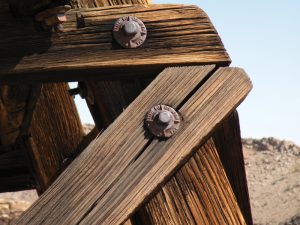
Shrinkage and Fasteners Since timber shrinks as it seasons until it reaches equilibrium moisture content, it is particularly important that timber structures, when built using unseasoned/green timber, be inspected for tightness of fasteners during the early life of the structure. This is done so that the capacity of the connections is not reduced by the development of a gap between timber members in a joint as a result of shrinkage. After a timber reaches equilibrium moisture content, it will typically continue to have small dimensional changes due to seasonal variations in temperature and relative humidity, although these are generally inconsequential.
Contractors prefer screws for their fast installation and reduced impact on the remaining amount of wood relative to drilling a hole for the bolt(s). It is most effective to install the screws where the wedging action force is on the fastener compressing the wood. To attempt to close the separation completely would tend to crush the wood fibers around the fastener and introduce undesirable tension perpendicular to grain stresses. The NDS specifies avoidance of configurations leading to their initiation since tension-perpendicular-to-grain design values for wood are not published.
If a large variance of greater than 10 percent from highest to lowest moisture content during and after construction is anticipated, the preventive measures discussed earlier can be used. However, installing stitch bolts or self-tapping screws to reinforce checks or splits should not be placed in-line with close spacing, or the checking or splitting may be exacerbated as the wood continues to shrink and swell due to minor seasonal fluctuations. In tension and compression splices, separate splice plates for each row of fasteners or saw kerfs between longitudinal rows of fasteners might be advantageous.
The repair of timber members with checks (and splits), when needed, should not cause any reduction to the structural capacity of the member, if possible. The repair should not restrict the timber member from shrinkage/swelling movements due to seasonal changes in ambient conditions, including those from the heating/cooling systems that result in changes in wood moisture content.
For timbers exposed to the elements that have checks, the checks should not be filled with a sealant. Leaving the checks open allows moisture to drain or evaporate if the timber gets wet. Filling the check with any sealant potentially traps moisture that can lead to decay.
Summary and Conclusion
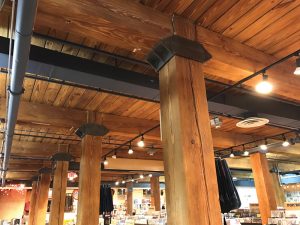
Building with timbers can satisfy high load requirements while providing a rustic appearance (Figure 6). Seasoning checks are natural characteristics that develop as timbers dry. Checks are accounted for when timbers are graded, primarily for appearance, not structural capacity, as the design values for structural timber grades are not affected by checks.■
